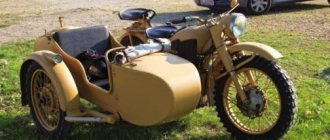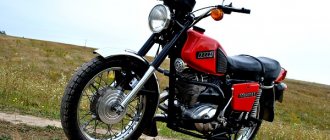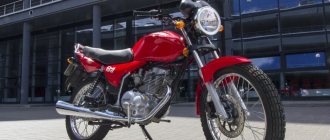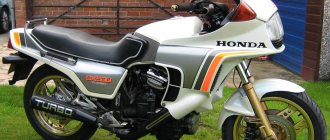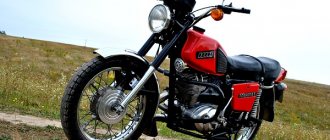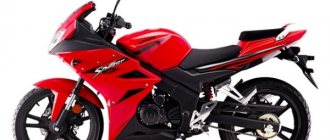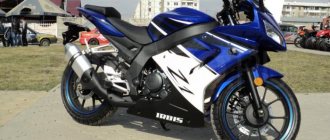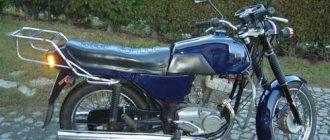Cats are castrated to tame their character and improve the environment. By purchasing a motorcycle, on the contrary, you want to emphasize your character, masculinity, expand the mating area and the variety of partners. Therefore, they usually choose the most charismatic, noisy, aggressive and environmentally harmful specimen. Motorcycle manufacturers understand this motivation very well. But for some reason sometimes they do the opposite. PDF version
“Eurogoose” BMW F650GS is good for training driving and for girls
The first gear clicks loudly, the gas is almost all the way, and... you can call for a smoke break - right during acceleration. The BMW F650GS demonstrates the dynamics of a dead roach in the lower reaches of a sewer. The owner boasted of stunning fuel efficiency figures, and from the very first meters of the journey it becomes clear that he was not lying. An engine running on single molecules of gasoline is a priori incapable of dynamically accelerating a motorcycle. Apparently this is why his sound is dry, quiet and emotionally distilled. The complete absence of vibrations only exacerbates the feeling of spinelessness.
The motorcycle was accelerated to 160 km/h. There is no great pleasure in driving at this speed, because the chassis and suspension work at the limit and the slightest irregularities take it beyond the limits of the operating range, and the dynamics at speeds close to maximum are so sluggish that you have to plan overtaking, almost like on a budget sedan.
The engine of the younger “goose” works well in all modes, but does not shine with a bright character
The Beemer box is clear and “light”. The gear ratios for this rather boring engine turned out to be well chosen, which somewhat brightens up the overall picture. Upshifts without a clutch are unclear, but this feature cannot be considered a serious drawback - the 650 “goose” is still not a sportbike. The reaction of the gearbox to attempts to engage the non-existent “minus first” and sixth gears is interesting. Unlike some “Japanese” ones, the leg of the box does not rest against the “wall”, but falls into “nowhere”, showing the pilot that he is demanding the impossible.
The German-style fuel injection system rations gasoline sparingly, allowing the bike to accelerate without jerking at a speed of 40 km/h in fifth gear. The acceleration didn’t even feel like a 400, but rather like a 250 or another two-stroke “staff”. The degree of emasculation of the F650GS for the sake of ecology, efficiency and gentle character is amazing. Some 400 cc enduros , which do not pretend to be any serious sportiness, accelerate faster in higher gears.
BMW F650GS fork suffers from a lack of compression damping
The suspension of the small “goose” is in complete harmony with the engine. She's no good. The fork does not provide the required amount of compression damping, which is why the motorcycle bites heavily under vigorous braking. If you catch the middle hole, you can easily earn a breakdown.
The BMW F650GS monoshock works well and makes it easy to adjust the spring preload
The monoshock absorber, unlike the non-adjustable fork, works tolerably and even allows you to change the spring preload without using a special key, which is useful when traveling with luggage and a passenger. But the owners, most likely, will not want to evaluate this opportunity, since under the weight of the “second number” and a trunk full of rubbish, the remnants of the accelerating dynamics will be buried alive. A small bonus - the monoshock spring preload adjustment knob has “clicks”, so it will be easier to remember settings changes.
The BMW F650GS pilot does not feel very confident on gravel
Due to the low energy consumption of the suspension and the road size of the tires, the F650GS feels uncomfortable outside of asphalt. It will, of course, digest dry hard primer or gravel. But nothing more. On wet, dirty or loose surfaces, considerable weight, a sluggish engine and almost one hundred percent asphalt tires take their toll. If you drive standing, the situation improves a little, but you still feel with every cell of your spinal cord that you won’t be able to make a bullet from this “substance.”
The brakes of the BMW F650GS guarantee good deceleration and decent feedback, and the spoked wheels can withstand heavy loads.
The brakes deserve good words. Brembo calipers reliably and adequately slow down the motorcycle even from maximum speeds and stubbornly do not overheat. The front brake, without the notorious electric booster, allows precise dosing of force, which is why ABS rarely activates during normal, non-extreme driving. If the wheels do lock, ABS quickly and proportionately prevents the development of a dangerous situation.
Fortunately, the ABS of the BMW F650GS motorcycle is switchable
A huge plus of the ABS system installed on the F650GS is the ability to turn it off. This is especially useful, for example, on mountain gravel roads, where anti-lock can significantly lengthen the braking distance. And in light of the fact that European legislators are seriously considering the possibility of banning manufacturers from installing switchable ABS on motorcycles, this option becomes doubly attractive.
BMW F650GS remote controls with classic design
Another joy is the consoles of a classic design. Unlike traditional BMW ones (with three control buttons for turn signals), you don’t have to get used to them for several days. However, instead of turning off the turn indicators, the finger occasionally hit the horn button, which is why some drivers looked askance at the pilot as if he were a “teapot” blowing the whistle for no apparent reason.
Control buttons for ABS and heated grips BMW F650GS
In addition to the remote controls, I liked the heated steering wheel grips. They are really very comfortable. Even after a couple of hundred kilometers, the hands did not experience discomfort or fatigue, and remained warm in the cold. The excellent saddle also makes its contribution, allowing it to easily cover impressive distances without developing hemorrhoidal syndrome, as well as for not very tall pilots to place all their feet on the asphalt. Unfortunately, it is also convenient for the passenger, so you will have to come up with special excuses to throw the woman off the “cart.”
On asphalt, the goose is easy to control, copes well with long journeys and is even suitable for training driving.
A comfortable body position and wind protection complete the ergonomic picture. Well-placed footrests do not force even tall pilots to bend their knees excessively, the wide handlebar makes maneuvering easier and allows you to sit with a slight forward lean, and the high glass effectively protects against air flow.
While in the saddle, I had to look for the side stand during the day with a flashlight. The first time the process took more than a minute, as I got used to it the time was reduced to fifteen to twenty seconds. But it was not possible to perfect it to the standard two-second “kick” with the left heel. The side stand folds with a loud clatter of metal on metal. There is nothing wrong with this, apparently the elastic band was just lost. The bike rises onto the center stand very easily, so even after a tedious job, setting up the motorcycle with a loaded pannier will not be difficult.
The BMW F650GS instrument panel is ascetic, but the readings are easy to read
Studying the functions of the dashboard took about seven and a half seconds - the device turned out to be radically ascetic. Speedometer, odometer, tachometer, clock, a set of familiar indicator lights and just one mileage counter. It is difficult to get lost in such a “forest”. The appearance of the device is unprepossessing, but the readings can be read confidently.
The fuel tank of the BMW F650GS has been moved from the traditional place under the saddle
The designers took a non-standard approach to the location of the gas tank and its filler neck. It is located under the passenger’s right knee, and in the usual place in front of the pilot there is an oil tank cap. To check the oil level there is an inspection window located on the side of the left fork leg. But it is very difficult to see anything intelligible through it.
– It turns out that “geese” have no udders! - By the way, the pilot too...
The manufacturer positions the F650GS as a bike for beginner lovers of the brand who want to try the taste of owning Bavarian equipment without the risk of being disappointed by losing an impressive amount. Unfortunately, in addition to the understandable desire of the developers to meet a moderate budget by abandoning some of the functions and capabilities of their older brothers, a piece of the 650’s soul and manhood was inadvertently cut off. Because of this, a wonderful device came off the assembly line for lonely 89-year-old pizza delivery people who despise the noise of engines, advocate for the environment, fuel economy and sincerely respect the peace of their neighbors. Like a eunuch in a harem, such a “goose” does not pose a serious danger to girls.
Anton Barsukov Photo by Viktor Akilov and the author
The author thanks Alexander “Zavedenny” Glushkov from the “Voron” motorcycle club for providing the “BMW F650GS” for testing.
The 650 cc Rotax is reliable and economical, but heavily choked by electronics. The rear wheel of the BMW F650GS is equipped with a plastic “mudguard” On asphalt, the “goose” is easy to control, copes well with long-distance travel and is even suitable for training driving
Technical specifications
General data Model: BMW F650GS Model year: 2003 Weight with fuel and oil, kg: 193 Dimensions, mm: 2175*910*1265 Wheelbase, mm: 1479 Seat height, mm: 780 Gas tank volume, l: 17.3
Engine Type: 1-cylinder, 4-stroke, dry sump Timing: DOHC, 4 valves per cylinder Displacement, cc: 652 Dimension, mm: 100 x 83 Compression ratio: 11.5 Max. power hp at rpm: 50/6500 Max. torque Nm at rpm: 60/5000 Power system: Fuel injection Cooling system: liquid Starting system: electric starter
Transmission Clutch: multi-disc, oil bath Box: 5-speed gear Final drive: chain
Chassis Frame : duplex, steel Front suspension: telescopic fork Front wheel travel, mm: 170 Rear suspension: pendulum, with monoshock absorber Rear wheel travel, mm: 165 Brake system: hydraulic Front brake: 1 300mm disc, 2-piston floating caliper Rear brake: 1 disc 245mm, 1-piston floating caliper Front tire: 100/90-R19 Rear tire: 130/80-R17
Note for beginners
However, do not write off the BMW F650GS, as it has all the necessary characteristics for beginners, which many of its analogues cannot boast of. By choosing this “Bavarian horse” for yourself, you will learn to control the motorcycle, plan and overtake competently, and develop a reaction. Let's take a closer look at the characteristics of the BMW F650GS and its features so that we can get a proper idea of the motorcycle.
Design Features
This model boasts its own fuel supply system, which is incredibly economical. It accurately doses gasoline, which allows you to smoothly accelerate the motorcycle, engaging fifth gear already at a speed of 40 km/h. The braking system also turned out to be more than successful. However, it is worth considering the fact that when braking sharply, the motorcycle can lean forward strongly, which can lead to a fall over the handlebars.
The monoshock absorber installed on the BMW F650GS copes with its immediate tasks perfectly. Even without a special key at hand, you can easily adjust the spring preload, the settings of which can be saved. As a rule, for many this will seem like an insignificant advantage of this model, but when you are on the road and your bike is loaded with luggage and a passenger, due to this you can save a colossal amount of effort and time. Since we mentioned the passenger, it must be said that the BMW F650GS completely loses its dynamics, becoming slow and clumsy with two adults on board.
It is also not recommended to use the motorcycle on roads that do not have asphalt surface. Referring to reviews from owners of the BMW F650GS, we can say that the bike becomes difficult to control on sand, mud, gravel, etc. This is due to the fact that the motorcycle is equipped with a low-energy suspension, as well as tires whose tread does not have lugs.
Characteristics
The BMW F650GT is equipped with a two-cylinder in-line engine, the latest development from the manufacturer, with a displacement of 650 cc. Engine power is 60 horsepower at 7500 rpm, torque at its maximum value is 66 Nm and is transmitted to a continuously variable transmission.
The cylinder is designed with a frontal inclination of 70 degrees, and allows the engine to be located at a low level, as a result of which the scooter has a low center of gravity. Thanks to the 90-degree shift of the contact handle, the BMW 650gt has a specific sound and a low vibration level.
The fuel supply system is equipped with an electrical system, which is made of 4 valves and two camshafts. The required temperature is maintained by the cooling system, which is designed for high-quality engine operation. The BMW c650gt exhaust system is designed in accordance with GOST Euro-4 exhaust emissions and is made of stainless steel. The suspension of the BMW c650gt is hybrid and consists of a gear-type frame, as well as a cast block with bearings. Stable movement is ensured by a light pendulum. The BMW C 650 GT is equipped with the latest and greatest braking system. It consists of one brake disc mounted on the rear wheel and two rotor discs on the front, their diameter is 270 mm. Safety while driving is ensured by the ABS system.
713
Advantages
When it comes to the advantages of the BMW F650GS, we would like to focus on the braking system, which demonstrates excellent feedback and good deceleration. The front brake is activated very rarely, thanks to the correct dosage of the applied force. The presence of ABS means that in the event of wheel locking, the system will help avoid a dangerous situation.
Prudent designers made it possible to completely disable ABS. With the system deactivated, it is easier to climb a mountain or overcome sections of the road without asphalt. One thing to consider is that with ABS turned on, your braking distance will be much shorter. European organizations have long proposed a ban on the installation of ABS with the possibility of turning it off. So the owners of this BMW received a nice bonus.
The design of the remotes deserves a positive assessment, which is incredibly simple and has nothing superfluous, allowing the biker to quickly understand the device. The remote control has only three buttons, like other motorcycles of this German brand. However, there have been cases when an inexperienced biker got confused even with this simple device and instead of pressing the button to turn off the turn indicators, he pressed the horn button. The motorcycle automatically turns on the horn, which can not only confuse you, but also greatly frighten you.
A pleasant and useful additional feature is the heated steering wheel grips. This will make your trip as comfortable as possible, especially in spring or autumn, as well as in mountainous areas where the air does not warm up even in the summer.
The seat is wide and comfortable. Many owners note that even after traveling long distances they did not experience fatigue or pain in the buttocks. The seating position is as low as possible, which makes the motorcycle attractive for short people. The position of the footrests is extremely good; even a tall biker will not have to bend his knees. The steering wheel is wide, allowing excellent maneuvering and keeping your hands in a comfortable position, which is important from the point of view of comfort. The windshield is high and wide. It will reliably protect the motorcyclist from oncoming air currents and midges.
BMW F 650 GT description
The BMW F650 GT was created to combine all the best aspects of scooter travel with exceptional maneuverability and comfort for a great experience. The production of this scooter takes place at the BMW Motorrad plant located in Berlin.
The BMW f650 gt is designed for people who pay attention to the comfort and functionality of a scooter. The new product represents a unique design project from BMW Motorrad, which has set modern standards in this segment. Modernity and dynamics are a good example to describe this model.
Dashboard
The dashboard is classic. Only important information is displayed on it, which is perfectly readable even in direct sunlight, allowing the biker to better concentrate on the road. On the instrument panel we will find:
- Speedometer.
- Odometer.
- Distance meter.
- Indicators for gasoline, engine temperature, turns, etc.
- Tachometer.
- Watch.
A distinctive feature is the non-standard location of the fuel tank, which is located on the right side of the passenger seat.
Technical characteristics of the BMW F650GS
This model has a very durable frame, which significantly improves the handling of the motorcycle, allowing you to feel the road well. The basic package looks like this:
- Reliable bridge frame.
- Front suspension - telescopic fork.
- The rear suspension is a double box swingarm.
- Front shock absorber travel is 170 cm, rear shock absorber travel is 165 cm.
- The rear shock absorber is single.
- Wheelbase – 1479 mm.
- The front wheel diameter is 19 inches, the rear wheel is 17 inches.
- Consumption per 100 km – 3.2 l (at an average speed of 90 km/h).
- The clutch is disc.
- Manual transmission - five-speed.
- Dry weight – 175 kg.
- Height – 820 mm.
- Fuel tank volume – 14 l.
- Recommended fuel type is AI-95.
- Fuel system - injector.
- Engine – four-stroke, single-cylinder.
- Volume – 652 cm3.
- Power – 36.5 kW (50 hp).
- Torque – 60 Hm.
- Drive – chain.
BMW gs 650 technical specifications
The engine is considered the pride of manufacturers. For the BMW 650 gs, a two-cylinder four-stroke engine was installed, the displacement of which is 798 cubic meters. see. Engine power is 72 hp, which gives the motorcycle high-quality traction power. The weight of the motorcycle with a filled tank is 200 kg. The maximum speed that can be achieved in the BMW 650gs is 185 km/h, this is an excellent indicator for a motorcycle of this class. The six-speed transmission is integrated into the engine crankcase. The reserve volume of the gasoline tank is 4 liters, and the useful volume is 16 liters. In terms of consumption characteristics, for those who like to travel a lot at a normal travel speed of 90 km/h, 3.6 liters of gasoline are consumed per 100 km of road. For those who like to drive at high speeds, gasoline consumption will be 5.3 liters, which is a noticeable difference. Regardless of the occasion, the BMW 650 is a motorcycle that can cover long distances.
The specially designed chassis of the BMW 650gs allows the owner to easily and comfortably control the motorcycle, overcoming various difficulties on the road. Also, the technical characteristics of the BMW GS 650 include the front fork, the reach of which is 92 mm with an inclination of 64 degrees. Thanks to this, driving the motorcycle becomes very easy, and the rear wheel suspension only adds to the comfort of driving the BMW 650 gs. The suspension itself is impressive - the front is 180 mm and the rear is 170 mm, which is why the motorcycle can travel on any road without difficulty. The wheels of the BMW 650gs are cast and made of aluminum, which gives them low weight.
The good price category of the BMW 650 gs allows you to experience the comfort of an S class motorcycle, as well as get pleasure and a sense of freedom from every trip.
BMW F650GS: Dakar modification review
In order to attract more attention to the line, the concern's designers were tasked with changing some of the technical characteristics of the existing model, making the motorcycle suitable for off-road travel. This is exactly how the BMW F50GS Dakar turned out. It comes factory equipped with a 21-inch front wheel, which is equipped with an aggressive all-terrain tread tire. These tires have proven themselves to be excellent both on difficult terrain and on roads with perfect asphalt surface. The front and rear suspension springs boast 21cm of travel, allowing them to withstand enormous loads during aggressive off-road driving. This model does not have an ABS system. The seat is comfortable and wide. The height of the bike without load is 88 cm, which allows motorcyclists whose height exceeds 175 cm to have confident contact with the road.
BMW F650GS
The new family of small BMW crossovers was initially met with hostility by many fans of the brand: the motorcycle, developed together with Aprilia, received a single-cylinder Rotax engine and a chain drive, unconventional for the Bavarian school. Despite this, it captivated buyers in many countries and brought the brand many new fans.
STORY
In 1993, BMW introduced a completely new model, the F650, developed jointly with Aprilia. Instead of the GS index, the lightweight tourenduro received its own name - Funduro. The road version, which differed in the diameter of the front rim (17 versus 19 inches), was called Strada. The 650 cc liquid-cooled single-cylinder engine, developed jointly with Rotax, had two Mikuni carburetors and two spark plugs in the cylinder head. Despite the chain drive, which replaced the traditional cardan, and one “pot” instead of the well-proven boxer, the car was a success among both experienced motorcyclists and motorcycle tourists, as well as among novice riders, becoming an excellent desk for them. Production of the Funduro and Strada ceased in 2001, and a year earlier BMW showed the public a new generation of the 650, called the F650GS.
The updated “goose” received a new frame and an injection power system, and the gas tank “moved” from its usual place under the saddle, significantly lowering the car’s center of gravity. The design has changed significantly: the corners and edges were replaced by rounded shapes, and the front fender, mounted on the fork, was supplemented by a second one, installed directly under the headlight, like its older brother. At the same time, ABS began to be installed on the car, albeit optionally.
The road version of the 650 received the CS (city/street) index and differed from the “goose” in its extravagant design, cast wheels and cantilever pendulum, and a belt took the place of the chain drive. The motorcycle did not repeat the success of the GS and was discontinued in 2006.
The 650 GS was also produced in the Dakar version, which featured increased suspension travel, a 21-inch front wheel and paint, as well as rigid protection for the rider’s hands and a higher windshield. In 2003, the 650 line was refreshed, and the mounting location of the front wheel axle on the front shock absorbers changed (due to complaints about its insufficient strength).
In 2007, the F650GS was replaced by a completely updated G650X family (enduro G650X Challenge, roadster G650X Country and motard G650X Moto), and since 2008, when the production of the old “geese” was discontinued, the F index was given to new, two-cylinder 800 cc models - F650GS and F800GS.
2010 was the last year for the G650X; The “goose” of the 2000 model actually returned to the assembly line, which received the name G650GS, and with it a new design and “casting” instead of the usual spokes. The equipment also includes switchable ABS. In 2011, sales of the more off-road G650GS Sertao began, differing in color and spoked wheels.
FOR WHAT?
The BMW 650GS is a universal car, suitable for both commuting and industrial trips, the geography of which is determined only by the owner’s desire. In the city, a narrow and squat motorcycle feels like a fish in water: excellent Bremb brakes and considerable suspension travel contribute to active driving, including on curbs; it’s not for nothing that this car is in the service of the capital’s traffic police.
Long trips are facilitated by a comfortable seating position and a 20-liter (in versions with ABS - 17-liter) tank, which, together with a very modest consumption, makes it possible to bludgeon more than 300 kilometers without stopping, and good suspension and spoked wheels will help you not to pay attention on the quality of asphalt or lack thereof. But for heavy off-road use, the Dakar version is more suitable: a 21-inch front wheel and large suspension travel will help not only to go far from civilization, but also to return back. Only vibrations transmitted to the seat and steering wheel can darken the distance, although in comparison with single-cylinder competitors they are small.
WHERE TO LOOK?
“Jies” come to Russia mainly from Europe and Japan; There are specimens brought from America. They are mainly sold by private owners, and if you want to be the first owner in Russia, second-hand shops or companies that deliver motorcycles from abroad will come to your aid. Officially, “geese” were also sold here, so it is not difficult to find a “white” copy purchased and serviced at a dealer, and the dealers themselves, along with new ones, offer to buy used cars for trade-in.
CHOICE
The motorcycle has no serious problems, except, perhaps, for the weak fastening of the front wheel axle. Under high loads, cracks appear on the lower part of the feathers, and sometimes the axle is completely torn out of the feathers. Since the end of 2003, all 650s have been equipped with fork cups with a reinforced axle mounting point.
The pump on the “goose”, despite its reliability, begins to leak over time, and its impeller wears out. An antifreeze leak from under the cover on the left is a clear sign of the death of the seals, and the condition of the impeller can only be truly checked when the pump is removed; It will circulate antifreeze through the system even with half-broken blades, and at the very least the engine will still be cooled. At the same time, it is worth paying attention to the condition of the plastic gears of the pump drive: with high mileage, they tend to wear out. Repairing a water pump will not require any special skills or costs: a repair kit consisting of a pair of oil seals and an impeller is inexpensive, and even a novice mechanic can assemble and disassemble the pump.
The steering column bearings cannot be called the weak point of the “goose”, but if the nut on the steering column is not tightened in a timely manner, the races will still break. It’s not difficult to check their condition: placing the motorcycle on the center stand and hanging the front wheel, grab the front shock absorbers and rock them back and forth; If there is play, you should think about replacing the bearings; fortunately, for a “non-original” one they ask for about 1200 rubles. The condition of the needle bearings of the pendulum is checked in approximately the same way - we hang up the rear wheel and shake the pendulum; the presence of play is a clear sign of the demise of the bearings.
TUNING
On a standard “goose”, first of all, you should replace the original windshield with a taller one, fortunately there is plenty to choose from: BMW and aftermarket manufacturers offer several models of different heights, shapes and tints; The price difference is also noticeable: glass from the original tuning catalog will cost about 9 thousand rubles, “non-original” – from 2 to 7 thousand rubles; The situation is almost the same with hand protection: “original” from 15 to 18 thousand rubles, depending on the model, aftermarket – 2.5-3 thousand rubles. Arcs will help protect the motor on the sides during falls, for which they will ask from 5 to 11 thousand rubles, and from below - a metal tray (10 thousand rubles). In the city, a central trunk will come in handy (from 6 to 17 thousand rubles, depending on the volume and manufacturer). Hard side panniers (30-45 thousand rubles) or their more budget-friendly soft textile analogues will help expand the cargo potential for long-distance food trucks. The central trunk in a long-haul car can also be replaced with a transformable soft bag (8.5 thousand rubles).
Flaws
If we consider the elements of the outer skin of the motorcycle, which many experts speak about in a very positive way, highlighting, for example, the vertical windshield, we can find several shortcomings. To do this, it is enough to drive just a few kilometers, after which you will form your own opinion. The windshield, which is praised by professional designers, does protect against air flow, but at the same time creates a certain semblance of turbulence. This can cause dust and small debris to start getting into your eyes, clogging them. In order not to lose concentration and maintain control over the situation on the road, it is extremely necessary to have special glasses or a helmet.
On the back of the motorcycle there is a special bracket on which you can attach the case. The BMW F650GS also has its own (factory) luggage compartment, but its lid is quite easy to open.
What changed
The motorcycle is equipped with new spoked wheels and also has a different body color. It is thanks to the black and gray color in which the Sertao is painted that the bike has a more aggressive appearance. The suspension has received more travel, as well as stiffer settings, which significantly improves off-road maneuverability and maneuverability. Especially for extreme sports enthusiasts, it became possible to install auxiliary (additional) equipment.
As a rule, the engine installed is the same as on the classic F650GS, but for some countries a less powerful modification will be produced, the engine of which can produce only 34 hp. With. The braking system also remains the same, ABS can be turned off.
BMW F650 (F650CS, F650GS, F650ST)
Model class : touring enduro.
Years of production/sales : 1993-2012
The BMW F650 motorcycle model series appeared in 1993, offering the market two models - the BMW F650 Funduro (alternative name - F650) and the BMW F650 Strada (alternative name - F650ST). These motorcycles were developed jointly with Aprilia, which, in turn, launched its own model, the Aprilia Pegaso 650. There were many differences between the BMW and Aprilia models, but the concept was the same: it was based on a 1-cylinder engine from the Austrian company Rotax with a capacity of about 650 cc, steel frame, simple suspension and universal chassis, suitable for both asphalt and dirt roads.
Despite the lack of technologies used on BMW's flagship motorcycles, the BMW F650 model, due to its low cost, gained enormous popularity in Europe - from 1993 to 2000. Almost 51,000 motorcycles were sold, and versions 2000-2007. – more than 105,000 pcs.
Main modifications of the BMW F650:
- BMW F650 (Funduro) is an enduro version of the motorcycle. Produced from 1993 to 2000. It has a 19' front wheel, off-road tires, an extended wheelbase (1480 mm), increased seat height (820 mm), a temperature indicator on the dashboard and a special shape of the front part with a windshield.
- BMW F650ST (Strada) – road version of the motorcycle. Produced from 1996 to 2000. It has an 18' front wheel, road tires, a shortened wheelbase (1465 mm), a lower seat height, suspension with less travel (120 mm versus 170 mm in the Funduro version), a clock instead of temperature indicators on the dashboard, special design of the front of the motorcycle and windshield.
- BMW F650GS – produced from 2000 to 2007. and replaced the previous BMW F650. It has a new injection engine, a new design, versions with heated steering grips and ABS.
- BMW F650GS (800cc) - produced from 2008 to 2012. It is distinguished by a 2-cylinder engine, alloy wheels and appearance. It has common features with the F800GS, but has lower engine performance and has cheaper equipment (1 brake disc, regular fork, etc.)
- BMW F650CS (Scarver) - produced from 2000 to 2007. and replaced the Strada modification (F650ST). It differs in appearance, 17' road wheels, dashboard, cantilever rear swingarm, trunk in place of the gas tank and belt drive.
- BMW F650GS Dakar – the version is similar to the BMW F650GS, but in the original coloring and Dakar inscription, a 21' front wheel (in the standard version - 19'), suspensions with increased travel and, accordingly, a higher saddle height.
The BMW F650GS model was produced until 2007, after which it was replaced by the new BMW F650GS model, which, despite the same name, was a completely different motorcycle with an inline 2-cylinder engine with a capacity of about 800 cc. cm.
In 2009, the BMW concern decided to “resurrect” the once popular 1-cylinder motorcycle BMW F650GS, offering the market a new model - the BMW G650GS. It's essentially the same F650GS, but with more modern looks and an engine assembled in China using Rotax parts. Despite the technical similarity of the F650GS (2000-2007) and the G650GS, we consider the latter as a separate model on the corresponding page of the Encyclopedia.
Owners' opinion
Motorcyclists who have a bike of this model in their garage, as a rule, leave only positive reviews on the forums. The BMW F650GS has established itself as a comfortable and easy-to-ride motorcycle. Many people note the fact that it is easy to overcome city traffic jams on a bike, since the steering wheel is located quite high, allowing you to maneuver between densely parked cars. A particularly pleasant point for owners is that the motorcycle is incredibly economical. In mixed mode, it consumes only 4 liters per hundred kilometers.
Having good technical characteristics, the BMW F650GS is capable of demonstrating good results when driving in mountainous areas. It can overcome almost any slope, but much depends on the experience and necessary skills of the motorcyclist.
Speaking about the disadvantages of the F650GS, the owners most often complain about the windshield, which creates not only turbulence but also serious noise when driving on highways. The disadvantages include the high cost of a new motorcycle, which is about 350 thousand rubles. It is also worth considering the costs of routine maintenance and repairs.
But, despite everything, the F650GS has incredibly high demand in the domestic market. This motorcycle was able to win the hearts of many bikers, who affectionately call it “Goose”.
Honda XL700V Transalp: comparative test drive with BMW F650GS
The Honda Transalp 700 with a new engine of seven hundred “cubes” represents a certain moment in the process of turning medium-sized enduros into SUVs, and the “younger brother” of the real enduro, the completely updated BMW F650 (don’t pay attention to the number, in fact, the volume of its engine is almost 800 cm3) is its worthy rival, ready for tough competition, regardless of where it will take place: on the road or off-road.
Honda XL700V Transalp
To better evaluate the potential capabilities of both bikes, we chose a route consisting of both long stretches of asphalt and dirt roads that were acceptable for their compromise tires. Corsica is ideal for these motorcycles. This is an impressive and charming land with lots of beautiful scenery, ribbons of asphalt that invite spirited driving and dirt roads of varying degrees of difficulty.
This is how Honda changed
Transalp XL700V is an evolution of the legendary model from back in 1987, which has changed many times over the years, but never radically.
In this new guise of the “SUV”, Honda has not lost its characteristics of the “for all occasions”, “universal purpose motorcycle” type, although its chassis has been greatly changed along with the appearance and all mechanics, emphasizing it (becoming more “road-friendly” ) character: the 21” wheel was replaced with a “19” one. As for the design, the Japanese designers left the common features of the “family” unchanged, changing mainly the front part to give it a more modern look. Another innovation is the injection two-cylinder V-twin engine, which has grown by only 33 cm3, but is noticeably “spurred” in the mid-speed zone.
Honda has practical hooks on the trunk that make it easy to hook an elastic net for securing bags.
As we were able to see, the purpose of changing the old model was not just to obtain higher performance, but to give the owner even more pleasure from BMW units, which over the previous years of the model’s existence had become an ideal in terms of elasticity and ease of driving.
BMW for the city
The F650GS is an unprecedented model that replaced the single-cylinder ancestor of the same name in the price list of the German manufacturer. This is a very important motorcycle for BMW, which can now show customers new performance and characteristics, as well as offer them greater freedom, especially in the city.
The old single-cylinder engine was very different from its “big” brother with a boxer engine. And if you take into account that the great ease of driving was contrasted with low weight and an engine with performance levels far from those of the flagship R1200GS, then it becomes clear why it was necessary to “fill the niche”.
In this completely new motorcycle, BMW designers chose to use the parallel twin with electronic injection and four valves per cylinder, already tested in the F800 series models, which is quite logical. Possessing more power and better running performance, this engine received a completely changed timing mechanism, it is attached to the frame differently (performing a load-bearing role) and produces 71 hp “on the mountain”. at 7000 rpm.
Honda XL700V Transalp
The devices provide quite a lot of information; To switch from one function to another, use the “mode” button on the steering wheel. The fact that the tank is located under the saddle can be considered a tradition.
The challenge has been issued
Two motorcycles, so similar in their performance characteristics and intended purpose, turned out to be very different even at the first acquaintance. The position of the driver in the saddle is very different: with Honda it is more consistent with the requirements of an off-road motorcycle - the saddle is higher, the seat is more upright, the handlebars are raised, angled and close to the level of the saddle.
The BMW has a lower saddle (two additional height options are available), it is comfortable for women and beginners, and the handlebar is low and straight.
On the highway, the behavior of both motorcycles is almost flawless, largely due to the use of 19" front wheels on both.
Agriates Desert
A 12 km long dirt road passes through it, which starts from the Casta fork and leads to Saleccia beach. The road is broken, damaged by the wind, and when it rains, driving conditions worsen. One piece of advice - be sure to fill the tank full: there are no gas stations along the road! If the motorcycle stalls, you will have to push it yourself: an emergency vehicle will not get there.
A simplified cast wheel (compared to the “off-road” 21'' spoked wheel) provides better handling and straight-line stability.
After a short, easy section of the road, you can allow yourself the pleasure of riding on a good slope at low speed (and on both motorcycles). As for driving on the road, it is necessary to note the excellent BMW brakes, informative and always ready for extreme braking.
Our F800GS came with ABS, which can be disabled for off-road use. The brakes on the Honda are even better, although here you need to press the lever more confidently. The Transalp also comes with ABS, but it cannot be switched off, which prevents the bike from being fully usable on dirt. Both motorcycles have good ergonomics, but there are some slight vibrations.
Both engines can be given a good rating, but for different reasons: the Honda V-twin is more torquey and excites the blood at mid-range speeds (between 3500 and 7000 rpm). BMW's parallel twin is more perky, but requires more than 6,000 rpm to impress with its dynamics, while keeping the adrenaline levels high thanks to the pleasant and enticing tonality of the stock exhaust.
Trial by Fire
Thirty-five kilometers of dirt road, sand, stone, descents and ascents, crossed in a single impulse - this is how we imagined this run, which was supposed to lead us to the sea. The route is interesting, of medium difficulty, without cross jumps, but with a constant change of soil.
BMW F650GS
Despite the fact that these motorcycles are more intended for touring than for off-roading, they got out of this situation: once they reached the speed necessary to overcome bumps (at low speeds, due to their considerable weight, their handling is not up to par), the Transalp and F650GS did an excellent job with all types of soil, although the engines received a couple of blows to the almost unprotected crankcases. In this regard, the crankcase is better protected in the Honda, but in the BMW, stones sometimes hit the engine.
The suspensions of both do an excellent job of smoothing out road imperfections (with the Honda having some advantage, showing progressive fork travel and being less prone to flatout.
When adopting a position typical for driving on the ground (standing on your feet and holding the tank with them), the Transalp'e drive is very precise, also thanks to the ideal location of the control levers. The BMW paid for its more pronounced road character - a low steering wheel (too low to provide adequate contact on a winding road) and a worse rear brake pedal and gearshift foot placement for tall drivers.
Even under these conditions, we were able to evaluate the delivery of engines that are able to restore speed from any speed, and get out of trouble even in the most critical situation. Indeed, the two-cylinder “pulls” out of obstacles without the need (as is usually the case) to press the clutch.
On dirt roads, the F650GS's long gears force you to use first gear on the toughest, slowest sections. This forces the motorcyclist to pay great attention to the speed increase lever, so as not to suddenly lose traction of the drive wheel with the surface.
In any case, both motorcycles have their habitat on asphalt, but the Honda is a little better suited for light off-road trips. If your favorite places to travel are motorways and country roads, then BMW can offer you a little more fun.


